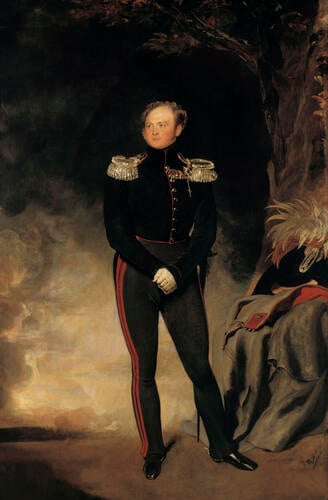-
1 of 253523 objects
Alexander I, Emperor of Russia (1777-1825) 1814-18
Oil on canvas | 273.8 x 179.5 x 2.9 cm; 4.6 cm (Depth) (support, canvas/panel/stretcher external) | RCIN 404942

Sir Thomas Lawrence (1769-1830)
Alexander I, Emperor of Russia (1777-1825) 1814-18
-
Lawrence was the most fashionable and also the greatest portraitist of his generation. He was made Principal Painter to George III in 1792 after Reynolds's death, and received occasional commissions; however it was only after 1814 that George IV began to employ him in earnest.
This portrait was created for what became the 'Waterloo Chamber', a great hall on the public route at Windsor Castle displaying portraits of those soldiers, sovereigns and diplomats responsible for the overthrow of Napoleon and the re-establishment of the monarchies and states of Europe thereafter. The concept began in 1814 when George IV used the opportunity of the Treaty of Paris to commission Lawrence to paint distinguished visitors, including the Tzar who arrived in London on 7 June 1814. The group of portraits grew during the next decade as Lawrence continued to obtain portrait sittings at the various congresses following the Battle of Waterloo in 1815; the Tzar's porrtait was completed during the Congress of Aix-la-Chapelle in 1818. Most of the twenty eight portraits were delivered after his death on 7 January 1830. By this time work was already begun of the space of the Waterloo Chamber created by covering a courtyard at Windsor Castle with a huge sky-lit vault; the room was completed during the reign of William IV (1830-7). The first illustration of the interior is provided by Joseph Nash (1809-78) in 1844 (RCIN 919785) and shows the arrangement which survives to this day: full-length portraits of warriors hang high, over the two end balconies and around the walls; at ground level full-length portraits of monarchs alternate with half-lengths of diplomats and statesmen.
Alexander I remained a determine opponent of Napoleon until the two met at Tilsit in 1807; their alliance was however broken by the French invasion of Russia in 1812 at which point the Russian army contributed more than any other to the final outcome. The Tsar is here shown as a warrior as well as monarch having participated in the Battle of Leipzig in 1813; he wears the uniform of a Russian Field-Marshal against the smoke of that Battle, his military greatcoat and plumed hat laid on a bank beside him; he wears the Sword of the Order of Sword of Sweden and the star of St Andrew of Russia superimposed upon the Garter.
While working on the portrait Lawrence altered the position of the legs, much to the consternation of the Tsar and those courtiers attending the portrait sitting, especially when for a while the sitter was shown with four legs.Provenance
Commissioned by George IV for 500 guineas; added to the inventory of Carlton House dated 1819 (no 652); taken to the Waterloo Chamber at Windsor Castle, where it appears in Joseph Nash's watercolour of 1844 (RCIN 919785)
-
Medium and techniques
Oil on canvas
Measurements
273.8 x 179.5 x 2.9 cm; 4.6 cm (Depth) (support, canvas/panel/stretcher external)
267.5 x 173.3 cm (sight)
Category
Object type(s)
Other number(s)
Alternative title(s)
Alexander I, Tsar of Russia (1777-1825)